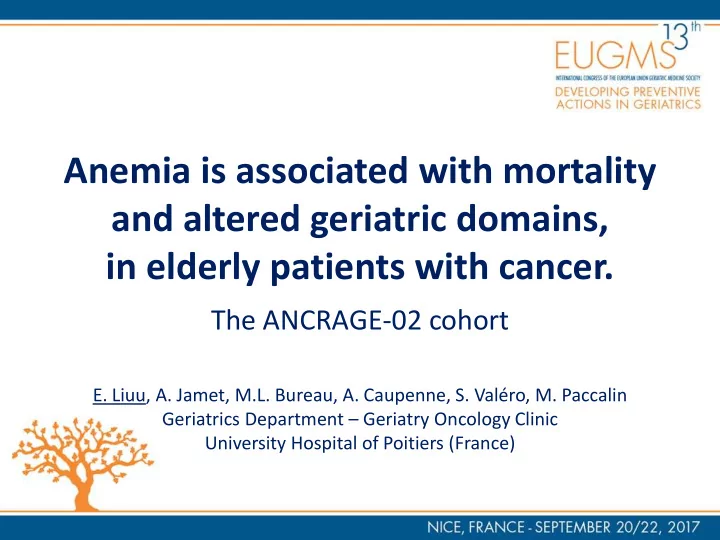

Anemia is associated with mortality and altered geriatric domains, in elderly patients with cancer. The ANCRAGE-02 cohort E. Liuu, A. Jamet, M.L. Bureau, A. Caupenne, S. Valéro, M. Paccalin Geriatrics Department – Geriatry Oncology Clinic University Hospital of Poitiers (France)
CONFLICT OF INTEREST DISCLOSURE I have no potential conflict of interest to report
BACKGROUND • Cancer : major public health challenge, notably in older adults • Management of cancer in elderly: recommendation for CGA • identification of health problems • correction of potential modifiable risk factors of poorer outcomes. SIOG 2012, NCCN 2017
BACKGROUND • Cancer : major public health challenge, notably in older adults • Management of cancer in elderly: recommendation for CGA • identification of health problems • correction of potential modifiable risk factors of poorer outcomes. SIOG 2012, NCCN 2017 • Anemia: common condition in older adults Patel, Semin Hematol 2008; Gaskell, BMC Geriatr 2008 • Association with mortality, disability, decline of quality of life Balducci, CROH 2007; Eisenstaedt, Blood Rev 2016
BACKGROUND • Cancer : major public health challenge, notably in older adults • Management of cancer in elderly: recommendation for CGA • identification of health problems • correction of potential modifiable risk factors of poorer outcomes. SIOG 2012, NCCN 2017 • Anemia: common condition in older adults Patel, Semin Hematol 2008; Gaskell, BMC Geriatr 2008 • Association with mortality, disability, decline of quality of life Balducci, CROH 2007; Eisenstaedt, Blood Rev 2016 • Objectives : to assess the prevalence of anemia in a cohort of older cancer patients, to identify the associated factors and the prognostic value.
PATIENTS AND METHODS • ANCRAGE survey: prospective open cohort survey Inclusion of consecutive patients aged ≥ 75 years Solid cancers or hematological malignancies Referred to the geriatric oncology clinic of Poitiers University hospital
PATIENTS AND METHODS • ANCRAGE survey: prospective open cohort survey Inclusion of consecutive patients aged ≥ 75 years Solid cancers or hematological malignancies Referred to the geriatric oncology clinic of Poitiers University hospital • ANCRAGE-02: inclusion between January 2009 and December 2016
PATIENTS AND METHODS • ANCRAGE survey: prospective open cohort survey Inclusion of consecutive patients aged ≥ 75 years Solid cancers or hematological malignancies Referred to the geriatric oncology clinic of Poitiers University hospital • ANCRAGE-02: inclusion between January 2009 and December 2016 • CGA: functional status, mobility, nutrition, mood, cognitive status, comorbidities • Anemia: WHO criteria: <130 g/L <120 g/L mild 110-129 g/L 110/119 g/L moderate 80-109 g/L severe < 80 g/L • Survival
FLOW CHART
RESULTS Caracteristics of patients • Mean age: 81.8 ± 4.9 years • Female: 49% • Most frequent cancer types: breast (16%), urinary tract (15%), prostate (14%), skin (12%) and colorectal (11%). • Metastatic disease: 30% • Anemia in 490 patients (44%): severe in 6 patients, moderate in 195 patients (41%) mild in 289 patients (59% )
CGA data according to anemia and its severity No anemia Anemia P Mild Moderate Severe p ADL ≤ 5/6 144 (23%) 191 (39%) <0.0001 99 (34%) 91 (47%) 3 (50%) <0.0001 Risk of falls 284 (46%) 265 (54%) 0.0001 154 (53%) 109 (56%) 2 (33%) 0.0005 MNA < 23/30 301 (49%) 280 (57%) <0.0001 158 (55%) 119 (61%) 3 (50%) <0.0001 GDS ≥ 6/15 148 (24%) 160 (33%) <0.0001 82 (28%) 76 (39%) 2 (33%) <0.0001 MMSE ≤ 24/30 121 (20%) 104 (21%) <0.0001 62 (21%) 42 (22%) 0 <0.0001 CIRS-G 5.9 ± 3.3 7.8 ± 4.2 <0.0001 7.3 ± 3.9 8.5 ± 4.5 10.0 ± 5.5 < 0.0001
CGA data according to anemia and its severity No anemia Anemia P Mild Moderate Severe p ADL ≤ 5/6 144 (23%) 191 (39%) <0.0001 99 (34%) 91 (47%) 3 (50%) <0.0001 Risk of falls 284 (46%) 265 (54%) 0.0001 154 (53%) 109 (56%) 2 (33%) 0.0005 MNA < 23/30 301 (49%) 280 (57%) <0.0001 158 (55%) 119 (61%) 3 (50%) <0.0001 GDS ≥ 6/15 148 (24%) 160 (33%) <0.0001 82 (28%) 76 (39%) 2 (33%) <0.0001 MMSE ≤ 24/30 121 (20%) 104 (21%) <0.0001 62 (21%) 42 (22%) 0 <0.0001 CIRS-G 5.9 ± 3.3 7.8 ± 4.2 <0.0001 7.3 ± 3.9 8.5 ± 4.5 10.0 ± 5.5 < 0.0001
Kaplan-Meier plot for survival in anemic vs. non anemic patients
Kaplan-Meier plot for survival in anemic vs. non anemic patients Multivariate analysis: aHR = 1.59 (95% CI, 1.34-1.89, p<0.0001)
Kaplan-Meier plot for survival according to severity of anemia
CONCLUSION • High prevalence of anemia in elderly patients with cancer. • Strong association with higher prevalence of altered geriatric domains and poorer survival.
CONCLUSION • High prevalence of anemia in elderly patients with cancer. • Strong association with higher prevalence of altered geriatric domains and poorer survival. paves the way for prospective interventional studies, in geriatric oncology settings, taking account of a systematic recognition and control of anemia.
Recommend
More recommend